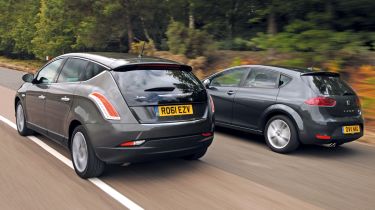Chrysler Delta vs SEAT Leon FR
Striking hatch tackles bold family five-door
If you’ve been on holiday to Europe lately, you’ve probably seen a Delta – but badged as a Lancia rather than a Chrysler. The spacious cabin and sophisticated styling ensure the car is a big seller on the Continent, yet it has taken three years for the right-hand-drive Chrysler-badged model to make its way across the Channel.
The styling has been left alone, so the Italian flavour is retained, and during our time with it, the Delta attracted lots of attention. Whether these were admiring glances or inquisitive stares is hard to judge – either way, the car clearly makes a big impact.
If you’re after a family hatch with flair, the established SEAT Leon already does the job pretty well. With its swept-back lights, curved roofline and taut rear end, it looks sporty when standing still, while clever design features like the hidden rear door handles have stood the test of time.
Yet even lined up against one of the most distinctive cars in the sector, the Delta stands out. With a large grille, projector headlights and heavily contoured bonnet, the front end is very bold. The car’s profile is arguably its best angle. Here, the curved waistline runs from the tip of the LED daytime running lights at the front to the intricate tail-lamps at the rear. Climb aboard and the upmarket feel continues, but it doesn’t last. While the dash materials are soft to the touch, the silver-effect centre console trim is disappointingly cheap and some of the Fiat-derived switchgear feels flimsy.
Used - available now

2023 Land Rover
Range Rover Evoque
21,916 milesAutomaticPetrol1.5L
Cash £28,500
2021 Tesla
Model 3
30,193 milesAutomaticElectric
Cash £18,800
2023 Tesla
Model 3
55,994 milesAutomaticElectric
Cash £18,000
2023 Mercedes
CLA
36,008 milesAutomaticDiesel2.0L
Cash £21,200There’s a decent range of driving position adjustment, but the pedal layout is a little cramped – overall, the SEAT’s functional and simply laid-out cabin is easier to get on with. The Leon is also more solidly screwed together, with a recent update improving material quality. Look beyond the fact that the optional sat-nav is too low down, and it’s hard to fault the ergonomics, plus the FR’s sporty steering wheel is great to hold.
In the back, the SEAT trails on space. The Chrysler has an extra 122mm between the wheels, and offers more legroom than any other car in its class. Better still, the rear seats split 60:40, slide back and forth and recline by 25 degrees, so it’s easy to get comfortable. With the seats in their forward-most setting (where legroom matches the SEAT), the Delta has 124 litres more boot space, with a 465-litre capacity. Even with them pushed back, it has 29 litres more room.
On this evidence, it’s easy to see why the Chrysler appeals, especially as wind and road noise are well isolated from the cabin. So it’s a shame the ride isn’t more accomplished. It isn’t as firm as the FR, which features sports suspension, but the Delta’s dampers don’t prevent thumps from potholes and expansion joints juddering up into the cabin. This is a shame because it can’t match the Leon’s handling. The FR has quicker reactions, less body roll and the front tyres don’t surrender their grip so soon.
The Chrysler’s steering is light, and gets even lighter if you press the city button. But the weighting is inconsistent either side of the straight ahead, plus you get some kickback through the column – so despite a relatively positive turn-in, the Delta lacks feel.
The 1.6-litre Multijet diesel trails on capacity, and has 20bhp less power than the SEAT’s 138bhp 2.0-litre TDI. Plus, the Delta is 105kg heavier than its rival, so it was no surprise that it took more than two seconds longer to cover 0-60mph, in 11.8 seconds.
Slower reactions in the higher gears are evidence of the 20Nm torque deficit. And while the Chrysler is refined in the mid-range, it becomes strained at higher revs; the SEAT is a bit gruff, but remains smooth.
The quirky Delta is a welcome arrival to the class. Yet the big question is whether it can overcome these flaws and establish itself as a major force in the competitive family hatch market.







